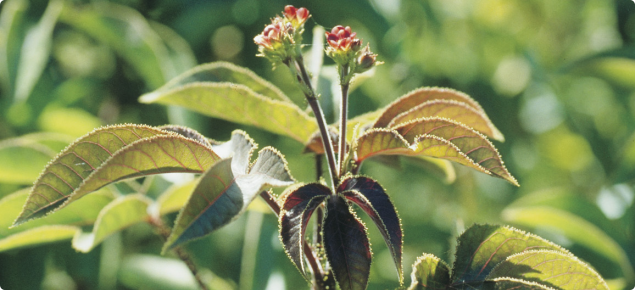What you should know about Jatropha species
Two Jatropha species are known to occur in Australia. These are physic nut, J. curcas, and bellyache bush, J. gossypiifolia. They are large shrubs or small trees in the spurge family, Euphorbiaceae, and both have toxic watery sap. They are closely related to the more familiar castor oil plant (Ricinus communis) and somewhat similar in appearance to it. Both are native to the Caribbean and central America.
Physic nut has several other common names, including tuba-tuba, Barbados nut and purge nut, but it is most widely known in Australia as physic nut.
Bellyache bush is naturalised in parts of the Kimberley, but physic nut is not known to be naturalised in Western Australia (WA).
Both species of Jatropha are declared plants (noxious weeds) in WA. This means that they cannot be grown or commercialised in this State; and they cannot be imported into this State.
What to look for
Bellyache bush (J. gossypiifolia) is an erect shrub to small tree, usually about three metres tall, densely covered with conspicuous glandular hairs.
The sticky three-lobed leaves are purple when young and green when mature. They are about 10cm across and borne on stalks up to 7cm long. The flowers are small, red, in stalked clusters among the upper leaves. It usually flowers from February to May, but can flower all year round under favourable conditions. It is a scattered weed of grazed woodlands, creeklines and wasteland in various parts of the Kimberley, also Port Hedland and, once, in Geraldton.
Physic nut (J. curcas) is an erect shrub to small tree 2-4m in height. Its leaves are green with three to five rounded lobes. They are about 15cm across and heart-shaped or similar to ivy.
The flowers are small, purple with yellow centres, and are produced in clusters in the leaf axils.
Life history of Jatropha species
Both species reproduce and spread mainly by seed, though physic nut can also produce some suckers. The plants produce seed capsules which 'explode' when ripe, spreading the large (1-2cm long) seeds for a few metres. Seeds spread over much longer distances when moved by water, or in soil on dirty vehicles, earth moving equipment, and so on. The seeds can survive several years in the soil.
Why Jatropha species matter
The Jatropha species are declared for several reasons, principally their toxicity to stock and humans, their invasiveness, and their ability to form dense stands that replace desirable plants in disturbed land and natural habitats.
Bellyache bush (J. gossypiifolia) in particular is naturalised in parts of the East and West Kimberley in the north of WA, where landholders mare obliged to control it to prevent its spread.
Jatropha species as biodiesel sources
There is currently a lot of publicity (particularly on the internet) regarding the use of oil from the fruits of Jatropha species as a source of biodiesel. Physic nut (J. curcas) is the species most commonly promoted on websites and elsewhere for biodiesel production; however, it is not known to occur in WA.
Much of the publicity material on Jatropha species as biodiesel crops points out that the plants are drought-tolerant, vigorous, lack pests and diseases, need no fertiliser, and are not eaten by livestock, even goats. These are the very characteristics that make Jatropha species serious weeds.
Their status as declared plants is unlikely to change, even with the increasing interest in the production of biodiesel. The Department of Agriculture and Food, Western Australia supports the production of biodiesel, but based on temperate oilseeds, especially canola, mustard and related crops.
Further information
For further information on Jatropha species, search this website or contact the Pest and Disease Information Service.


